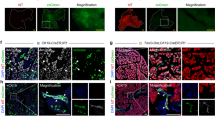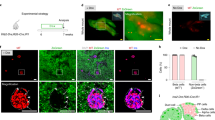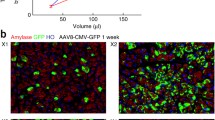Abstract
Revealing the mechanism of adult organ maintenance and regeneration after injury is fundamental to our understanding of the pathogenesis of diseases. Considering the results of pulse and chase experiments using inducible insulin-Cre or Elastase-Cre, and more recently HNF1b-Cre, adult pancreatic cells (beta, acinar, and duct cells) seem to be maintained by the self-duplication of the existing cells, while there is still a dispute about whether adult beta-cells are supplied from the duct cells. Here we describe the advantages and pitfalls of Cre-mediated genetic lineage tracing experiments in the analysis of embryonic organogenesis and adult organ maintenance of the pancreas. This experimental technique enables us to visualize the specific cells and their progeny in vivo, and the combination of lineage tracing and other experimental procedures provides us with more detailed information on the mechanism of organogenesis and adult organ homeostasis.



Similar content being viewed by others
References
Jensen J, Cameron E, Garay M, Starkey T, Gianani R, Jensen J. Recapitulation of elements of embryonic development in adult mouse pancreatic regeneration. Gastroenterology. 2005;128:728–41.
Sell S. Alpha-fetoprotein, stem cells and cancer: how study of the production of alpha-fetoprotein during chemical hepatocarcinogenesis led to reaffirmation of the stem cell theory of cancer. Tumour Biol. 2008;29:161–80.
Yang L, Jung Y, Omenetti A, Witek R, Choi S, Vandongen H, et al. Fate-mapping evidence that hepatic stellate cells are epithelial progenitors in adult mouse livers. Stem Cells. 2008;26:2104–13.
Petersen B, Bowen W, Patrene K, Mars W, Sullivan A, Murase N, et al. Bone marrow as a potential source of hepatic oval cells. Science. 1999;284:1168–70.
Desai B, Oliver-Krasinski J, De Leon D, Farzad C, Hong N, Leach S, et al. Preexisting pancreatic acinar cells contribute to acinar cell, but not islet beta cell, regeneration. J Clin Invest. 2007;117:971–7.
Strobel O, Dor Y, Alsina J, Stirman A, Lauwers G, Trainor A, et al. In vivo lineage tracing defines the role of acinar-to-ductal transdifferentiation in inflammatory ductal metaplasia. Gastroenterology. 2007;133:1999–2009.
Rovira M, Scott S, Liss A, Jensen J, Thayer S, Leach S. Isolation and characterization of centroacinar/terminal ductal progenitor cells in adult mouse pancreas. Proc Natl Acad Sci USA. 2010;107:75–80.
Siveke J, Lubeseder-Martellato C, Lee M, Mazur P, Nakhai H, Radtke F, et al. Notch signaling is required for exocrine regeneration after acute pancreatitis. Gastroenterology. 2008;134:544–55.
Krapp A, Knöfler M, Ledermann B, Bürki K, Berney C, Zoerkler N, et al. The bHLH protein PTF1-p48 is essential for the formation of the exocrine and the correct spatial organization of the endocrine pancreas. Genes Dev. 1998;12:3752–63.
Gradwohl G, Dierich A, LeMeur M, Guillemot F. Neurogenin3 is required for the development of the four endocrine cell lineages of the pancreas. Proc Natl Acad Sci USA. 2000;97:1607–11.
Gu G, Dubauskaite J, Melton D. Direct evidence for the pancreatic lineage: NGN3+ cells are islet progenitors and are distinct from duct progenitors. Development. 2002;129:2447–57.
Kawaguchi Y, Cooper B, Gannon M, Ray M, MacDonald R, Wright C. The role of the transcriptional regulator Ptf1a in converting intestinal to pancreatic progenitors. Nat Genet. 2002;32:128–34.
Sumazaki R, Shiojiri N, Isoyama S, Masu M, Keino-Masu K, Osawa M, et al. Conversion of biliary system to pancreatic tissue in Hes1-deficient mice. Nat Genet. 2004;36:83–7.
Fukuda A, Kawaguchi Y, Furuyama K, Kodama S, Horiguchi M, Kuhara T, et al. Ectopic pancreas formation in Hes1-knockout mice reveals plasticity of endodermal progenitors of the gut, bile duct, and pancreas. J Clin Invest. 2006;116:1484–93.
Vivian J, Gan L, Olson E, Klein W. A hypomorphic myogenin allele reveals distinct myogenin expression levels required for viability, skeletal muscle development, and sternum formation. Dev Biol. 1999;208:44–55.
Taranova O, Magness S, Fagan B, Wu Y, Surzenko N, Hutton S, et al. SOX2 is a dose-dependent regulator of retinal neural progenitor competence. Genes Dev. 2006;20:1187–202.
Fujitani Y, Fujitani S, Boyer D, Gannon M, Kawaguchi Y, Ray M, et al. Targeted deletion of a cis-regulatory region reveals differential gene dosage requirements for Pdx1 in foregut organ differentiation and pancreas formation. Genes Dev. 2006;20:253–66.
Fukuda A, Kawaguchi Y, Furuyama K, Kodama S, Horiguchi M, Kuhara T, et al. Reduction of Ptf1a gene dosage causes pancreatic hypoplasia and diabetes in mice. Diabetes. 2008;57:2421–31.
Messier B, Leblond C. Cell proliferation and migration as revealed by radioautography after injection of thymidine-H3 into male rats and mice. Am J Anat. 1960;106:247–85.
Bonner-Weir S, Baxter L, Schuppin G, Smith F. A second pathway for regeneration of adult exocrine and endocrine pancreas. A possible recapitulation of embryonic development. Diabetes. 1993;42:1715–20.
Zulewski H, Abraham E, Gerlach M, Daniel P, Moritz W, Müller B, et al. Multipotential nestin-positive stem cells isolated from adult pancreatic islets differentiate ex vivo into pancreatic endocrine, exocrine, and hepatic phenotypes. Diabetes. 2001;50:521–33.
Ianus A, Holz G, Theise N, Hussain M. In vivo derivation of glucose-competent pancreatic endocrine cells from bone marrow without evidence of cell fusion. J Clin Invest. 2003;111:843–50.
Dor Y, Brown J, Martinez O, Melton D. Adult pancreatic beta-cells are formed by self-duplication rather than stem-cell differentiation. Nature. 2004;429:41–6.
Xu X, D'Hoker J, Stangé G, Bonné S, De Leu N, Xiao X, et al. Beta cells can be generated from endogenous progenitors in injured adult mouse pancreas. Cell. 2008;132:197–207.
Inada A, Nienaber C, Katsuta H, Fujitani Y, Levine J, Morita R, et al. Carbonic anhydrase II-positive pancreatic cells are progenitors for both endocrine and exocrine pancreas after birth. Proc Natl Acad Sci USA. 2008;105:19915–9.
Solar M, Cardalda C, Houbracken I, Martín M, Maestro M, De Medts N, et al. Pancreatic exocrine duct cells give rise to insulin-producing beta cells during embryogenesis but not after birth. Dev Cell. 2009;17:849–60.
Kushner J, Weir G, Bonner-Weir S. Ductal origin hypothesis of pancreatic regeneration under attack. Cell Metab. 2010;11:2–3.
Author information
Authors and Affiliations
Corresponding author
About this article
Cite this article
Kawaguchi, Y., Takaori, K. & Uemoto, S. Genetic lineage tracing, a powerful tool to investigate the embryonic organogenesis and adult organ maintenance of the pancreas. J Hepatobiliary Pancreat Sci 18, 1–5 (2011). https://doi.org/10.1007/s00534-010-0307-z
Published:
Issue Date:
DOI: https://doi.org/10.1007/s00534-010-0307-z




